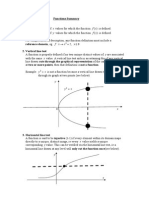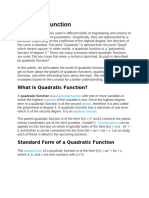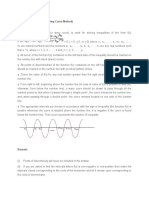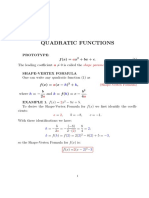0 ratings0% found this document useful (0 votes)
79 views2.quadratic Equation An Function of Second Grade
2.quadratic Equation An Function of Second Grade
Uploaded by
Ricardo ToledoThis document discusses key concepts related to quadratic equations and functions including:
1) The form of quadratic functions as f(x) = ax^2 + bx + c and how the a, b, and c coefficients relate to properties like the y-intercept, concavity, axis of symmetry, and vertex.
2) How to graph quadratic functions and determine features like the axis of symmetry and vertex.
3) How the discriminant relates to the number and type of roots of a quadratic equation.
4) The process and formula for finding the roots of a quadratic equation.
5) How changing the a, b, and c coefficients impacts the graph of the quadratic function.
Copyright:
© All Rights Reserved
Available Formats
Download as PPT, PDF, TXT or read online from Scribd
2.quadratic Equation An Function of Second Grade
2.quadratic Equation An Function of Second Grade
Uploaded by
Ricardo Toledo0 ratings0% found this document useful (0 votes)
79 views27 pagesThis document discusses key concepts related to quadratic equations and functions including:
1) The form of quadratic functions as f(x) = ax^2 + bx + c and how the a, b, and c coefficients relate to properties like the y-intercept, concavity, axis of symmetry, and vertex.
2) How to graph quadratic functions and determine features like the axis of symmetry and vertex.
3) How the discriminant relates to the number and type of roots of a quadratic equation.
4) The process and formula for finding the roots of a quadratic equation.
5) How changing the a, b, and c coefficients impacts the graph of the quadratic function.
Original Title
2.Quadratic Equation an Function of Second Grade
Copyright
© © All Rights Reserved
Available Formats
PPT, PDF, TXT or read online from Scribd
Share this document
Did you find this document useful?
Is this content inappropriate?
This document discusses key concepts related to quadratic equations and functions including:
1) The form of quadratic functions as f(x) = ax^2 + bx + c and how the a, b, and c coefficients relate to properties like the y-intercept, concavity, axis of symmetry, and vertex.
2) How to graph quadratic functions and determine features like the axis of symmetry and vertex.
3) How the discriminant relates to the number and type of roots of a quadratic equation.
4) The process and formula for finding the roots of a quadratic equation.
5) How changing the a, b, and c coefficients impacts the graph of the quadratic function.
Copyright:
© All Rights Reserved
Available Formats
Download as PPT, PDF, TXT or read online from Scribd
Download as ppt, pdf, or txt
0 ratings0% found this document useful (0 votes)
79 views27 pages2.quadratic Equation An Function of Second Grade
2.quadratic Equation An Function of Second Grade
Uploaded by
Ricardo ToledoThis document discusses key concepts related to quadratic equations and functions including:
1) The form of quadratic functions as f(x) = ax^2 + bx + c and how the a, b, and c coefficients relate to properties like the y-intercept, concavity, axis of symmetry, and vertex.
2) How to graph quadratic functions and determine features like the axis of symmetry and vertex.
3) How the discriminant relates to the number and type of roots of a quadratic equation.
4) The process and formula for finding the roots of a quadratic equation.
5) How changing the a, b, and c coefficients impacts the graph of the quadratic function.
Copyright:
© All Rights Reserved
Available Formats
Download as PPT, PDF, TXT or read online from Scribd
Download as ppt, pdf, or txt
You are on page 1of 27
Quadratic Equation and
Function of Second Grade
OBJECTIVES:
Know and apply mathematical concepts associated with
the study of the quadratic function.
Graph a quadratic function, determining vertex, axis of
symmetry and concavity.
Display graphic features of a parabola through
discriminant analysis.
Determine the intersection of the parabola with the
Cartesian axes.
Determine the roots of an equation of 2nd degree.
Content
1. Quadratic function
2. 2nd degree equation
1.1 Y axis intercept
1.2 Concavity
1.3 Axis of symmetry and vertex
2.1 Roots of a quadratic equation
2.2 Properties of the roots
2.3 Discriminate
1.4 Discriminate
1. Quadratic Function
It is of the form
f(x) = ax
2
+ bx + c
Examples:
And its graph is a parabola.
a) If f(x) = 2x
2
+ 3x + 1
b) If f(x) = 4x
2
- 5x - 2
a = 2, b = 3 y c = 1
a = 4, b = -5 y c = -2
con a =0; a,b,c IR
1.1. Intersection with Y axis
In the quadratic function f (x) = ax2 + bx + c, the
coefficient c indicates the ordinate of point Y where
the parabola intersects the axis
x
y
x
y
c
(0,C)
1.2. Concavity
In the quadratic function f (x) = ax2 + bx + c, the
coefficient a indicates whether the parabola is concave
up or down.
If a> 0,
is concave up
If a <0,
is concave downward
Then, the parabola intersects the Y axis at the point (0, - 4)
and is concave upward.
x
y
Example:
In the function f (x) = x2 - 3x - 4, a = 1 and c = - 4.
(0,-4)
The value of "b" in the equation allows to know the movement
horizontal parabola and the "a" concave.
Be the quadratic function f (x) = ax + bx + c
Then
IF a>0 y b<0 The parabola opens upward and is oriented to
right.
IF a>0 y b>0 The parabola opens upward and is oriented to
left
IF a<0 y b>0 The parabola opens downward and is
oriented to right
IF a<0 y b<0 The parabola opens downward and is oriented
left
1.3 The importance of the value of "a" and "b"
Ej. f(x)=2x - 3x +2
Ej. f(x)=x + 3x - 2
Ej. f(x)=-3x + 4x 1
Ej. f(x)=-x - 4x + 1
1.4. Axis of symmetry and vertex
The axis of symmetry is the line through the vertex of
the parabola, and is parallel to the axis Y.
x
y
Axis of symmetry
vertex
The vertex of a parabola is the highest or lowest point
of the curve, as its concavity.
IF f(x) = ax
2
+ bx + c , Then:
b) Its vertex is:
a) Its axis of symmetry is:
2a
2a
V =
-b , f -b
4a
-b , 4ac b
2
2a
V =
-b
2a
x =
Example:
21
-2
x =
In the function f(x) = x
2
+ 2x - 8, a = 1, b = 2 y c = - 8,
then:
V = ( -1, f(-1) )
a) Its axis of symmetry is:
x = -1
b) Its vertex is:
V = ( -1, -9 )
2a
-b
x =
-b , f -b
2a
2a
V =
f(x)
V = ( -1, -9 )
x = -1
Axis of symmetry:
vertex:
1.It means that the function is moved to the left or
right, h units and opens upward or downward.
Ex. 1) y=2(x-3) () 2) y=-3(x-4) ()
If y=ax any quadratic function, then:
2. y =a(x+h) means that the function is moved to the left or
right h units and opens up or down.
Ex. 1) y= 4(x+2) () 2) y=-(x+1) ()
1.5 Behavior of the function according to "a", "h" and "k"
x
y
x
y
x
y
3. y=a(x-h) k means that the function is moved to the
right or left k units up or down.
Ex. 1) y=5(x-1) - 4 () 2) y=-3(x-7) + 6 ()
4. y=a(x + h) k means that the function is moved to the
right or left k units up or down.
Ex. 1) y=(x+6) - 5 () 2) y=-5(x+3) + 3
()
Obs. V(h,k) is the vertex of the parabola.
x
y
f the parabola is opened upward, the vertex is
a minimum and if the parabola is open
downward, the vertex is a maximum.
The discriminant is defined as:
= b
2
- 4ac
a) If the discriminant is positive, then the parabola
intersects two points on the axis X.
> 0
1.6. Discriminate
If the discriminant is negative, then the
NO parabola intersects the axis X.
< 0
c) If the discriminant is zero, then the
parabola intersects at a single point to the X axis is
tangent to it.
= 0
x
2
x
1
2. Quadratic Equation
A quadratic or quadratic equation is of the form:
ax
2
+ bx + c = 0, con a 0
Every quadratic equation has two solutions or roots.
If these are real, correspond to points of intersection
of the parabola f (x) = ax2 + bx + c with the x-axis
x
2
x
y
x
1
Example:
In the function f (x) = x2 - 3x - 4, the associated equation:
x2 - 3x - 4 = 0, has roots -1 and 4.
Then the parabola intersects the X axis at those points.
2.1. Roots of an equation of 2nd degree
Formula for determining the solutions (roots) of a
quadratic equation:
- b b
2
4ac
2a
x =
Example:
Determine the roots of the equation: x
2
- 3x - 4 = 0
-(-3) (-3)
2
41(- 4)
2
x =
3 9 + 16
2
x =
3 25
2
x =
2
x =
3 5
2
x =
8
2
x =
-2
x
1
= 4 x
2
= -1
You can also obtain the roots of the equation by
factoring the product of binomials:
x
2
- 3x - 4 = 0
(x - 4)(x + 1) = 0
(x - 4)= 0 (x + 1)= 0
x
1
= 4 x
2
= -1
2.2. Properties of the roots
If x1 and x2 are the roots of a quadratic equation of
the form ax2 + bx + c = 0, then:
-b
a
x
1
+ x
2
=
c
a
x
1
x
2
=
a
x
1
- x
2
=
1)
2)
3)
Given the roots or solutions of a quadratic equation, you
can determine the equation associated with them.
a (x - x1) (x - x2) = 0
In a quadratic equation, the discriminant
= b
2
- 4ac
a) If the discriminant is positive, then the quadratic
equation has two real solutions x1, x2 and distinct.
The parabola intersects at
two points to the axis X.
> 0
2.3. Discriminate
Provides information on the nature of the roots.
x1, x2 are real and
x1 x2
x
2
x
1
b) If the discriminant is negative, then the quadratic
equation has no real solution.
The parabola NO X axis
intersects
< 0
x1, x2 are complex
conjugates
x1 = x2
c) If the discriminant is zero, then the quadratic equation
has two real and equal roots.
The parabola intersects
at a single point to the
axis X.
= 0
x1, x2 are real and
x1 = x2
x
2
x
1
=
1.-Questions
2-Exercises:
a)y = x-2.
b)y=4x-3.
c)y=x-6+x.
d)Y=x-5x+6.
e)Y=9-x.
You might also like
- H2 Maths Detailed SummaryDocument82 pagesH2 Maths Detailed SummarythatsparklexNo ratings yet
- Irrevocable Trust AgreementDocument12 pagesIrrevocable Trust AgreementTerrance Oates100% (4)
- Quadratic FunctionDocument25 pagesQuadratic FunctionCherry Grace Sagde EuldanNo ratings yet
- G9 Math Q1 - Week 6 - Quadratic Functions and Its GraphDocument27 pagesG9 Math Q1 - Week 6 - Quadratic Functions and Its GraphMechael ManzanoNo ratings yet
- G9 Math Q1 - Week 6 - Quadratic Functions and Its GraphDocument27 pagesG9 Math Q1 - Week 6 - Quadratic Functions and Its Graphmarkralston.garciaNo ratings yet
- FAEN 101: Algebra: Dr. Joseph K. AnsongDocument20 pagesFAEN 101: Algebra: Dr. Joseph K. Ansongnimdie jacksonNo ratings yet
- PolynomialsDocument42 pagesPolynomialsapi-296824694No ratings yet
- A.True or False: 1. If The Value of A 0, The Parabola Opens Upward and It Has A Maximum PointDocument19 pagesA.True or False: 1. If The Value of A 0, The Parabola Opens Upward and It Has A Maximum PointChinnajade BalangatNo ratings yet
- Ch10 The Quadratic FunctionDocument36 pagesCh10 The Quadratic Functiontrantuanan123No ratings yet
- Mod 9 ModifiedDocument8 pagesMod 9 Modifiedmartinaloreyn.delrosarioNo ratings yet
- Functions and EquationsDocument5 pagesFunctions and Equationsscribd-in-actionNo ratings yet
- 6.6 Analyzing Graphs of Quadratic FunctionsDocument22 pages6.6 Analyzing Graphs of Quadratic FunctionsCikgu Shaiful Kisas100% (1)
- Quadratic FunctionDocument9 pagesQuadratic FunctionanterojudeamaeNo ratings yet
- Maths in Focus - Margaret Grove - ch9Document34 pagesMaths in Focus - Margaret Grove - ch9Sam Scheding0% (1)
- ch10 PDFDocument36 pagesch10 PDFcathyNo ratings yet
- PC Graph QuadsDocument20 pagesPC Graph QuadsHector R.No ratings yet
- Grade 11 MathDocument4 pagesGrade 11 MathJay-Ann RamosNo ratings yet
- Quadratic Function and Factoring Quadractic EquationDocument14 pagesQuadratic Function and Factoring Quadractic EquationYvan OmayanNo ratings yet
- MATH9 Q1 WEEK6 ForprintDocument15 pagesMATH9 Q1 WEEK6 Forprintryo.wolloh.27No ratings yet
- Solving Quadratic Equation GraphicallyDocument15 pagesSolving Quadratic Equation GraphicallySour PlumNo ratings yet
- 10 5 Graphing ParabolasDocument15 pages10 5 Graphing Parabolasapi-233527181No ratings yet
- GraphsDocument6 pagesGraphsRhea Mae AmitNo ratings yet
- Lesson 3 Quadratic FunctionsDocument13 pagesLesson 3 Quadratic FunctionsChet Jerry AckNo ratings yet
- Math Unit 2Document14 pagesMath Unit 2Jessica MehraNo ratings yet
- ParabolasDocument2 pagesParabolasnooluoitNo ratings yet
- Graphing QuadraticsDocument14 pagesGraphing QuadraticsLey Taberna100% (1)
- 8graphing - Quadratics 1Document16 pages8graphing - Quadratics 1bernadeth villanuevaNo ratings yet
- Calc II ReviewDocument7 pagesCalc II ReviewPablo KhilopNo ratings yet
- Module 2 - Linear FunctionsDocument25 pagesModule 2 - Linear FunctionsRoger KhanNo ratings yet
- Practice Problems Section 2.1-2.7Document18 pagesPractice Problems Section 2.1-2.7maddieecomeauNo ratings yet
- Chapter 4作业hardDocument3 pagesChapter 4作业hardDowe XueNo ratings yet
- Module 2 - Quadratic FunctionsDocument20 pagesModule 2 - Quadratic FunctionsRoger KhanNo ratings yet
- Module 2 - Quadratic FunctionsDocument23 pagesModule 2 - Quadratic FunctionsAsh100% (1)
- Lecture 3.1Document9 pagesLecture 3.1mohanasasu1234No ratings yet
- Core 3 RevisionDocument3 pagesCore 3 RevisiondrjhmadNo ratings yet
- 2.6.3 Practice - Quadratic Functions (Practice)Document11 pages2.6.3 Practice - Quadratic Functions (Practice)johnnyhockey91100% (1)
- Unit 9 Lesson NotesDocument22 pagesUnit 9 Lesson Notesapi-291793268No ratings yet
- 5 1graphquadratics 101102195718 Phpapp01Document22 pages5 1graphquadratics 101102195718 Phpapp01Cikgu Shaiful KisasNo ratings yet
- The Method of IntervalsDocument12 pagesThe Method of IntervalsKumardeep MukhopadhyayNo ratings yet
- Equations and GraphsDocument15 pagesEquations and Graphsyusi rizaNo ratings yet
- Introduction To Calculus: H X F H X F X FDocument6 pagesIntroduction To Calculus: H X F H X F X FJonathan NguyenNo ratings yet
- MATHALGIIBU12Quadratic FunctionsDocument22 pagesMATHALGIIBU12Quadratic FunctionsMbocaBentoNo ratings yet
- Lecture 3Document3 pagesLecture 3Hari KrishnaNo ratings yet
- Parabola 2Document39 pagesParabola 2Venice Diane Flores Frivaldo100% (1)
- Polynomials Over Integers: Note PrintsDocument14 pagesPolynomials Over Integers: Note PrintsKomanduri Murali SrinivasNo ratings yet
- Coordinate Geometry IIDocument41 pagesCoordinate Geometry IIkrish1092pNo ratings yet
- 1.2 Graph Quadratic in Vertex or Intercept Form-0Document20 pages1.2 Graph Quadratic in Vertex or Intercept Form-0alexNo ratings yet
- Quadratic FunctionDocument13 pagesQuadratic FunctionJasmine Marie Padilla LimsonNo ratings yet
- Unit II Differential Calculus Part A Solutions ASCIIDocument2 pagesUnit II Differential Calculus Part A Solutions ASCIIu0106370No ratings yet
- 3.0 Review FunctionsDocument12 pages3.0 Review Functionsummu***No ratings yet
- Mathematics: Specimen NAB AssessmentDocument7 pagesMathematics: Specimen NAB Assessmenttaylor9916No ratings yet
- Areas (Part 1)Document7 pagesAreas (Part 1)Sachin KumarNo ratings yet
- AUC & Differential Equation & Binomial 13thDocument28 pagesAUC & Differential Equation & Binomial 13thRaju SinghNo ratings yet
- C1 Graphs of Functions QuestionsDocument6 pagesC1 Graphs of Functions QuestionsChaterine AdiwinotoNo ratings yet
- Chapter 2.2Document16 pagesChapter 2.2macboy3000No ratings yet
- Quadratic Functions: A A Shape ParameterDocument8 pagesQuadratic Functions: A A Shape ParameterAna Dela FuenteNo ratings yet
- X and Y-InterceptDocument21 pagesX and Y-InterceptjudeNo ratings yet
- Transformation of Axes (Geometry) Mathematics Question BankFrom EverandTransformation of Axes (Geometry) Mathematics Question BankRating: 3 out of 5 stars3/5 (1)
- Differentiation (Calculus) Mathematics Question BankFrom EverandDifferentiation (Calculus) Mathematics Question BankRating: 4 out of 5 stars4/5 (1)
- April Airtel BillDocument26 pagesApril Airtel Billpratej yadavNo ratings yet
- Modern Nepal College, Bagbazar, KathmanduDocument8 pagesModern Nepal College, Bagbazar, KathmandukulNo ratings yet
- Power Flow Analysis Using MATLAB: by MOHAMMAD NASER (092312) Najibullah (092314)Document137 pagesPower Flow Analysis Using MATLAB: by MOHAMMAD NASER (092312) Najibullah (092314)ET201040 Mohin UddinNo ratings yet
- Political Law Syllabus 2021Document4 pagesPolitical Law Syllabus 2021Francisco BanguisNo ratings yet
- ICPC Information Booklet Version 5 - April 2013 - ElectronicDocument12 pagesICPC Information Booklet Version 5 - April 2013 - ElectronicBen TudorNo ratings yet
- House Price Prediction Project ReportDocument36 pagesHouse Price Prediction Project ReportShashank ChowdaryNo ratings yet
- Cruzetas para MaquinariaDocument102 pagesCruzetas para MaquinariaErick Peña Gonzalez100% (1)
- Safety and Security Camera Acceptable Use Policy: 1.0 PurposeDocument7 pagesSafety and Security Camera Acceptable Use Policy: 1.0 Purposeabey.mulugetaNo ratings yet
- Report On Survey Camp Civil EnggDocument3 pagesReport On Survey Camp Civil EnggJodha SinghNo ratings yet
- Tax Incentives For BioNexus Status Companies Process and ProceduresDocument41 pagesTax Incentives For BioNexus Status Companies Process and Proceduresagasthia23No ratings yet
- Ultrasonic Level Transmitter Working PrincipleDocument17 pagesUltrasonic Level Transmitter Working Principlejomari100% (1)
- Cover TronvhfDocument2 pagesCover TronvhfHenry DengNo ratings yet
- Failure of APACHE Server BridgeDocument4 pagesFailure of APACHE Server BridgeEddy LauNo ratings yet
- Product Manual 03109 (Revision NEW) : 3161 GovernorDocument20 pagesProduct Manual 03109 (Revision NEW) : 3161 GovernorHelen BachtiarNo ratings yet
- MaruthanayagamDocument14 pagesMaruthanayagamlogan gunasekaranNo ratings yet
- The Business Model Canvas QiscusDocument1 pageThe Business Model Canvas QiscusIsmail AmrullohNo ratings yet
- Athanasios Angelou - Rhetoric and History The Case of Niketas ChoniatesDocument17 pagesAthanasios Angelou - Rhetoric and History The Case of Niketas ChoniatesNikolaos nikolaouNo ratings yet
- Roundhill OfstedDocument8 pagesRoundhill OfstedJatinder PablaNo ratings yet
- SSM Book U5Document17 pagesSSM Book U5geethuramesh1702No ratings yet
- Buyer's Request Form 1Document1 pageBuyer's Request Form 1April Givero SheaNo ratings yet
- Heirs of Lorenzo Buensoceso Vs Perez - G.R. No.173926 PDFDocument13 pagesHeirs of Lorenzo Buensoceso Vs Perez - G.R. No.173926 PDFpatricia.aniyaNo ratings yet
- List of FormatsDocument93 pagesList of FormatsBscpl Repalle to EeppurpalemNo ratings yet
- Mobile ApplicationDocument8 pagesMobile ApplicationAde Yeti N100% (1)
- Gokongwei Vs SECDocument18 pagesGokongwei Vs SECAnonymous PYorid9ANo ratings yet
- MB0044 - Production and Operations Management Assignment Set - 1Document8 pagesMB0044 - Production and Operations Management Assignment Set - 1Ravi GuptaNo ratings yet
- Exercise 15Document7 pagesExercise 15vaomaxemNo ratings yet
- WORKSHOPn3nnnSTARTUPS 6164ff1d500e8acDocument5 pagesWORKSHOPn3nnnSTARTUPS 6164ff1d500e8aclaura valentina montaño rodriguezNo ratings yet
- Ethics in Functional FieldsDocument34 pagesEthics in Functional FieldssagartolaneyNo ratings yet
- Sikalastic®-726 Balcony One Shot Part B: Safety Data SheetDocument11 pagesSikalastic®-726 Balcony One Shot Part B: Safety Data Sheetcphammond83No ratings yet

























































































